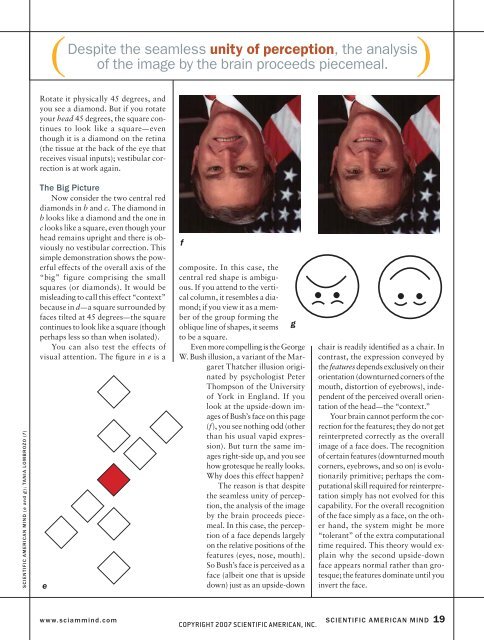Scientific American Mind-June/July 2007
Scientific American Mind-June/July 2007
Scientific American Mind-June/July 2007
You also want an ePaper? Increase the reach of your titles
YUMPU automatically turns print PDFs into web optimized ePapers that Google loves.
SCIENTIFIC AMERICAN MIND (e and g ); TANIA LOMBROZO (f )<br />
( Despite the seamless unity of perception, the analysis )<br />
of the image by the brain proceeds piecemeal.<br />
Rotate it physically 45 degrees, and<br />
you see a diamond. But if you rotate<br />
your head 45 degrees, the square continues<br />
to look like a square—even<br />
though it is a diamond on the retina<br />
(the tissue at the back of the eye that<br />
receives visual inputs); vestibular correction<br />
is at work again.<br />
The Big Picture<br />
Now consider the two central red<br />
diamonds in b and c. The diamond in<br />
b looks like a diamond and the one in<br />
c looks like a square, even though your<br />
head remains upright and there is obviously<br />
no vestibular correction. This<br />
simple demonstration shows the powerful<br />
effects of the overall axis of the<br />
“big” figure comprising the small<br />
squares (or diamonds). It would be<br />
misleading to call this effect “context”<br />
because in d—a square surrounded by<br />
faces tilted at 45 degrees—the square<br />
continues to look like a square (though<br />
perhaps less so than when isolated).<br />
You can also test the effects of<br />
visual attention. The fi gure in e is a<br />
e<br />
f<br />
composite. In this case, the<br />
central red shape is ambiguous.<br />
If you attend to the vertical<br />
column, it resembles a diamond;<br />
if you view it as a member<br />
of the group forming the<br />
oblique line of shapes, it seems g<br />
to be a square.<br />
Even more compelling is the George<br />
W. Bush illusion, a variant of the Margaret<br />
Thatcher illusion originated<br />
by psychologist Peter<br />
Thompson of the University<br />
of York in England. If you<br />
look at the upside-down images<br />
of Bush’s face on this page<br />
(f), you see nothing odd (other<br />
than his usual vapid expression).<br />
But turn the same images<br />
right-side up, and you see<br />
how grotesque he really looks.<br />
Why does this effect happen?<br />
The reason is that despite<br />
the seamless unity of perception,<br />
the analysis of the image<br />
by the brain proceeds piecemeal.<br />
In this case, the perception<br />
of a face depends largely<br />
on the relative positions of the<br />
features (eyes, nose, mouth).<br />
So Bush’s face is perceived as a<br />
face (albeit one that is upside<br />
down) just as an upside-down<br />
chair is readily identifi ed as a chair. In<br />
contrast, the expression conveyed by<br />
the features depends exclusively on their<br />
orientation (downturned corners of the<br />
mouth, distortion of eyebrows), independent<br />
of the perceived overall orientation<br />
of the head—the “context.”<br />
Your brain cannot perform the correction<br />
for the features; they do not get<br />
reinterpreted correctly as the overall<br />
image of a face does. The recognition<br />
of certain features (downturned mouth<br />
corners, eyebrows, and so on) is evolutionarily<br />
primitive; perhaps the computational<br />
skill required for reinterpretation<br />
simply has not evolved for this<br />
capability. For the overall recognition<br />
of the face simply as a face, on the other<br />
hand, the system might be more<br />
“tolerant” of the extra computational<br />
time required. This theory would explain<br />
why the second upside-down<br />
face appears normal rather than grotesque;<br />
the features dominate until you<br />
invert the face.<br />
www.sciammind.com SCIENTIFIC AMERICAN MIND 19<br />
COPYRIGHT <strong>2007</strong> SCIENTIFIC AMERICAN, INC.

















